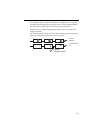
Glossary
71
describe how computers transmit data
with a destination address.
IP address
A series of numbers that identifies a con-
nection point or device on an IP network.
Each connection point and device needs a
unique IP address to communicate using
IP. For example, 192.168.1.1 is a sample
IP address.
IPSec
Internet Protocol (IP) Security. A set of
protocols used to help secure the exchange
of IP data. IPSec is being developed by the
Internet Engineering Task Force (IETF).
key
A set of bytes that encrypt or decrypt data.
Keys allow you to protect data from being
read by an intruder on the network. Keys
can be symmetric or asymmetric and
asymmetric keys can be either public or
private.
LAN
Local Area Network. A communications
network usually located within a building
or small number of buildings. For exam-
ple, computers and printers at many com-
panies are connected to a LAN.
lockdown
A description of a default behavior for a
computer that uses Packet Protect. A
Lockdown computer initiates and replies
to all communications by requesting secu-
rity; it only communicates using IPSec
(requires that the other computer also uses
IPSec). A common use for this setting is a
server that requires very restricted access.
MD5
Message Digest Algorithm. An algorithm
often used to verify the integrity of pack-
ets traveling on a network. The algorithm
transforms any number of bytes into a
fixed number of bytes; no other set of
bytes produces the same result.
network
One or more computers that are connected
together for communication purposes.
offload
The assignment of algorithm computa-
tions from software to hardware. Packet
Protect offloads security tasks to Intel
PRO/100 S Management and Server
adapters to speed processing and increase
network performance.
packet
A piece of data that travels on the network.
Each packet contains the data being trans-
mitted, along with a destination address.
Packet Protect protects packets as they
travel on the network using IPSec.
perfect forward secrecy
The generation of an additional key pair to
be used during data transfer. This helps
guarantee that no keys are re-used. Using
perfect forward secrecy increases protec-
tion, but generates more CPU utilization.
policy
A collection of security settings and rules
that are applied to a group of computers.
port
A connection point used by IP applica-
tions. For example, a Web server typically
sends and receives information on port 80.
pre-shared key
A secret password that a computer pre-
sents to help verify its identity. Pre-shared
keys are used during negotiation of a
secure communication. Each computer
must present the same pre-shared key in
order to communication using IPSec.
protocol
A set of guidelines that describe how net-


















